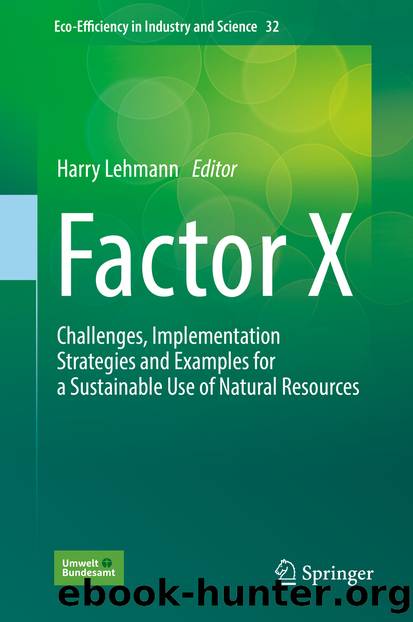Factor X by Harry Lehmann

Author:Harry Lehmann
Language: eng
Format: epub
Publisher: Springer International Publishing, Cham
13.4 Our Activities in Germany
We are proud to be one of the first countries in the world to have adopted a national resource efficiency programme, also known as ProgRess, on 29 February 2012.18
The aim of the German Resource Efficiency Programmes is to make the extraction and use of natural resources more sustainable and to minimise the environmental pollution associated with it to the furthest possible extent. In this way, we seek to create the basis needed to ensure a high quality of life on a permanent basis—also with a view to our responsibility for future generations.
The German government seeks to decouple economic growth from the use of resources as far as possible and reduce the associated environmental pollution, thereby making German industry more competitive and fit for the future, which in turn will promote stable employment and social cohesion. The resource efficiency policy is meant to help us shoulder our global responsibility for the environmental and social impacts of resource use. The aim must be to reduce the use of raw materials.
ProgRess deals with a selection of resources. ProgRess I focused on abiotic, non-energy resources, and also on biotic raw materials in material use. Energy resources were not included because their use was (and still is) the subject of comprehensive debate within the field of energy policy. The use of raw materials is connected with the use of other natural resources such as water, air, land and soil, biodiversity and ecosystems. However, since these resources are already covered by other programmes, processes or legislation, ProgRess does not address them in detail.
ProgRess I gives an overview of the wealth of activities that were already in place in 2012 and describes numerous approaches and measures for increasing resource efficiency (about 170 according to an internal list). It covers the entire value chain. It is about securing a sustainable raw material supply, increasing resource efficiency in production processes, making consumption more resource-efficient, expanding resource-efficient closed cycle management and using cross-sectoral instruments (Fig. 13.1).
Fig. 13.1ProgRess, 2012 (Source: © BMUB)
Download
This site does not store any files on its server. We only index and link to content provided by other sites. Please contact the content providers to delete copyright contents if any and email us, we'll remove relevant links or contents immediately.
Time Management Made Easy: How to Cultivate New Habits, Improve Productivity and Get Things Done by Joshua Strachan(2367)
The 7 Habits of Highly Effective People by Stephen R. Covey & Sean Covey(2098)
The Concise Laws of Human Nature by Robert Greene(1718)
Doesn't Hurt to Ask by Trey Gowdy(1555)
Primal Leadership by Daniel Goleman(1129)
Hook Point: How to Stand Out in a 3-Second World by Brendan Kane(1098)
HBR's 10 Must Reads 2021 by unknow(1045)
Don't Sweat the Small Stuff...and It's All Small Stuff by Richard Carlson(1016)
Amazon Unbound by Brad Stone(980)
100 Things Successful People Do by Nigel Cumberland(964)
HBR's 10 Must Reads 2021 by Harvard Business Review(956)
The Job Closer by Steve Dalton(939)
Master of One by Jordan Raynor(934)
Lives of the Stoics by Ryan Holiday & Stephen Hanselman(900)
Declutter Your Mind: A step by step guide to learn to control your thoughts, stop worrying, relieve anxiety and eliminate panic attacks and negative thinking by Mia Chandler(875)
The Power of 100! by Shaun King(845)
Conflicted by Ian Leslie(798)
Coders at Work: Reflections on the craft of programming by Peter Seibel(789)
The Book of Hope by Jane Goodall(744)
